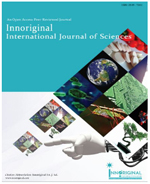MEDICINAL PROPERTIES OF BLACK TURMERIC: A REVIEW
Abstract
Curcuma Caesia commonly known as ‘Black Turmeric’ is a perennial herb with bluish-black rhizome of the family Zingiberaceae. This species has been gradually increasing in popularity in the interested community for its unmatched medicinal properties. In ethnomedicinal practices, the traditional healers use the genus Curcuma for the treatment of various types of diseases but Curcuma caesia Roxb. Is a very less known and almost untouched drug. Rhizomes of the plant have been explored for antifungal activity, smooth muscle relaxant and anti‑asthmatic activity, antioxidant activity, analgesic activity, locomotor depressant, anticonvulsant and muscle relaxant effects, anxiolytic and CNS depressant activity, anti‑bacterial activity, anti‑ulcer activity and many other miscellaneous activities.Keywords: Curcuma Caesia, black turmeric, perennial herb, traditional healers, medicinal uses.ÂReferences
European Agriculture. 2013; 14(3):110-115.
Black Turmeric or Curcuma caesia – Medicinal and rare. Siddha medicine and natural treatment.
Prasanthi Donipati.et.al. Preliminary Phytochemical Screening of Curcuma caesia. International Journal of Current Microbiology and Applied Sciences 2015; 4(11): 30-34.
Rajeshwari Sahu et.al. A brief review on medicinal value of Curcuma caecia. International journal of pharmacy & life sciences.2013;5(4): 2664-2666.
http://nurserylive.com
Satyendra Singh Baghel.et al. Pharmacological activities of Curcuma caesia. International Journal of Green Pharmacy. 2013; 7(1): 1-5.
Pritesh Paliwal.et.al. Pharmacognostic parameters for evaluation of the rhizomes of curcuma caesia. Journal of advanced pharmaceutical technology and research.2011; 2(1):56-61.
Prasanthi Donipati.et.al. Preliminary Phytochemical Screening of Curcuma caesia. International Journal of Current Microbiology and Applied Sciences 2015; 4(11): 30-34.
https://en.m.wikipedia.org.
Mehendra Kumar Dewangan.et.al. Medicinal value of curcuma cassia Roxb: an overview. Earth journals.2014; 3(4): 1-9.
Sonjit Das.et.al. Curcuma caesia Roxb. And it’s medicinal uses: a review, international journal of research in pharmacy and chemistry.2013; 3(2):370-75.
Angel G.R.et.al.Antioxidant and anti-inflammatory activities of proteins isolated from eight Curcuma species. J. Phytopharmacology.2012. 4(1): 96-105.
Hasan Muhammad Mohtasheemul.et al. Antiemetic Activity of Some aromatic plants. JPSI. 2012. 1(1): 47-49.
Indrajit Karmakar.et.al. Anxiolytic and CNS depressant activities of methanol extract of Curcuma caesia rhizome Pharmacologyonline.2011; 2: 738-747.
Paliwal P.et al. Comparative evaluation of some plant extracts on bronchoconstriction in Experimental animals. AJPLS. 2011: 1(1):52-57.
Kaur R.et al. Comparative study of analgesic and antipyretic activity of Curcuma caesia and Curcuma amada roxb. Rhizomes.Ethnopharmacology.2013;2(1):441/11
Karmakar I.et al. Neuropharmacological assessment of Curcuma caesia Roxb. Rhizome in experimental animal models. Orient Pharm Exp Med Springer 2011; 11:251-55.
Karmakar I.et al. Anxiolytic and CNS depressant activities of methanol extract of Curcuma caesia rhizome. Pharmacology online 2011; 2:738-47.
Gill R.et al. phytochemical investigation and evaluation of anthelmintic activity of Curcuma amada and Curcuma caesia-a comparative study. Ethnopharmacology.2013; 2(1).412/11.
Rajamma AG.et al. Antioxidant and antibacterial activities of oleoresins isolated from nine Curcuma species. Phytopharmacology.2012: 2(2); 312-317
Syeda Nishat Fathima1.et.al. Evaluation of In Vitro Thrombolytic Activity of Ethanolic Extract of curcuma caesia Rhizomes. International Journal of Pharma Research & Review, 2015; 4(11):50-54.
Indrajit Karmakar.et al. Neuropharmacological assessment of Curcuma caesia rhizome in experimental animal models. Oriental Pharmacy and Experimental Medicine.2011; 11(4), 251–255.
Yogamaya Dhal.et al. Comparative antioxidant activity of non-enzymatic and enzymatic extracts of Curcuma zedoaria, Curcuma angustifolia and Curcuma caecia. International journal of plant animal and environmental sciences.2012; 2(4): 232- 239.
Krishnaraj M.et al. A comparative study of phenol content and antioxidant activity between nonconventional Curcuma caesia Roxb. And Curcuma amada Roxb. International Journal of Plant Production.2010; 4 (3):169 -174.
Swarnamoni Das. (2012). Study of the anti-ulcerogenic activity of the ethanolic extracts of rhizome of Curcuma caecia (EECC) against gastric ulcers in experimental animals. Asian Journal of Pharmaceutical and Clinical Research.2012; 5(2): 200- 203.
C.R. Lalitha. et.al. Effect of curcuma caesia leaves on rice seed germination and seedling establishment Ancient Science of Life.1995; 15(2):115-118.
Arulmozhi DK.et al. Preliminary mechanistic studies on the smooth muscle relaxant effect of hydroalcoholic extract of Curcuma caesia. J Herb Pharmacother 2006;6:117-24
Angel gr, et.al. Antioxidant and antimicrobial activity of essential oils from nine starchy curcuma species. International Journal of Current Pharmaceutical Research.2012; 4(2):45-47.


